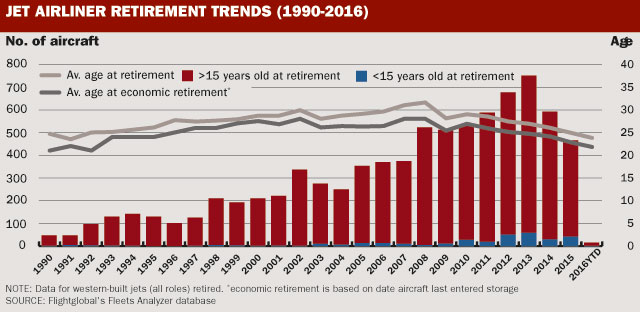Aircraft retirements have sharply declined since 2014 as airlines keep ageing equipment in service as a result of low fuel prices and strong passenger demand.
This would suggest a corresponding rise in aircraft age when equipment is eventually withdrawn from service. But the opposite is the case.
The average aircraft retirement age has fallen too. In fact, that decline began during the financial crisis in 2008 – long before the number of annual retirements started falling – and it has been driven by an increase in aircraft being prematurely decommissioned.
Flightglobal's Fleets Analyzer database shows that among Western-built commercial jets the number of retirements increased from 46 aircraft in 1990 to 751 in 2013, albeit with fluctuations caused by several economic downturns during that period.
But after a decommissioning peak in 2013, the number of retirements fell to 466 last year. This was the first time since 2007 that fewer than 500 aircraft were retired.
Rob Morris, head of consultancy with Flightglobal's advisory service Ascend, says the overall decline is no surprise as air travel demand has been strong while aircraft manufacturers' production and delivery have been "broadly stable".
Meanwhile, the average aircraft retirement age has steadily declined from a peak of around 32 years in 2008 to 25 in 2015.
The number of premature retirements – of aircraft up to 15 years old – hovered around 10 units per annum between 2003 and 2009, with a marked decline in 2008. However, the volume of premature retirements has significantly increased over the past six years and reached 58 aircraft in 2013.
Much of that rise has been driven by the removal from service of 50-seat regional jets which struggled to find market application amid the high fuel prices of a few years ago. But since 2008, nearly 100 narrowbodies from the Airbus A320 or Boeing 737 families have been disassembled before reaching their 15th anniversary of delivery.
Morris says the volume of disassembled narrowbodies indicates that "this early part-out phenomenon is far from the exception to the rule that many commentators argue".

Crucially, the proportion of premature retirements has grown as its number remained relatively stable – 42 aircraft were prematurely decommissioned last year – while the overall volume of retirements fell by a third between 2013 and 2015.
Last year, premature retirements accounted for 9% of decommissioned aircraft. That share stood was below 8% in 2013.
Morris believes the increased share of relatively young aircraft retirements is a result of a "production surplus" of new equipment entering airline fleets.
Especially in the wake of the 2008 financial crisis, aircraft which may have originally been ordered for predicted fleet growth were delivered in a period of soft traffic demand and consequently used for replacement rather than expansion. This led to decommissioning of mid-age aircraft that could have otherwise continued operating in service.
However, Morris also believes that despite increased air traffic demand in recent years, certain aircraft owners – typically lessors or financiers which don't operate the equipment – chose to disassemble rather than remarket maturing aircraft as they can realise better return from part sales than continued operation.
He argues that aircraft retirement age has become an instrument of responding to traffic demand fluctuations as manufacturers' production output has been stable despite economic downturns. "Obviously demand is still cyclical," says Morris. But he adds: "If production doesn't cycle, then something else has to cycle. And for the last three to four years, the new supply-side cycle is economic life."
The trend of declining retirements may be reversed as manufacturers plan to further raise production, which could lead to increased replacement of old aircraft. But if air travel demand softens, Morris suggests, increased aircraft production rates could also result in more premature retirements than is foreseen today.
A key question is how average aircraft retirement age will develop in future. Morris does not expect a rise in aircraft economic life, while the volume of decommissioned equipment could rise. But equally, he doesn't believe retirement age can decline much further beyond today's level as investors typically calculate their business with depreciation periods of 25 years. "You are not going to get aircraft coming out [of service] routinely at 18 years or less."
He expects that average retirement age "will probably bottom out at some point" and fluctuate "somewhere between 22 and 25 years" reflecting demand and supply cycles.
An earlier version included an inaccurate figure in a now-deleted final paragraph
Source: Cirium Dashboard























